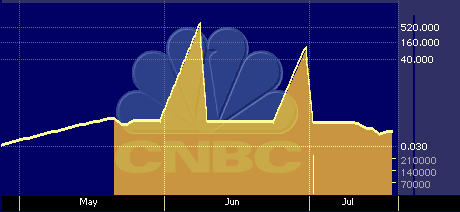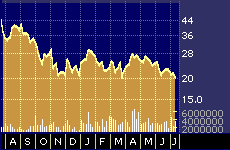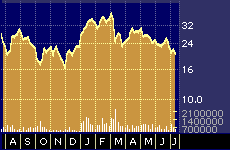
Upside Seen for Silicon Valley Stock
Upside Seen for Silicon Valley Stock
By Hal Plotkin
Silicon Valley Correspondent
Two analysts upgraded Silicon Valley Group Inc. {SVGI} last week — after the company beat quarterly consensus earnings estimates by 60 percent — saying that the stock has upside potential of 40 percent or more over the next 12 months.
On Monday, Ed White, an analyst with Lehman Brothers in New York, upgraded semiconductor manufacturing-equipment maker Silicon Valley Group’s stock to “outperform” from “neutral,” based on better-than-expected quarterly results and more-optimistic projections of future earnings.
The move followed on the heals of a similar upgrade by Robert Maire of Bear Stearns in New York, upgraded the stock to “attractive” from “neutral.”
White set a new 12-month price target of $35 for the stock. Maire is more ambitious: He has a 12-month target of $40.

One-year performance chart for SVGI
Silicon Valley Group’s stock has already moved up sharply, if unsteadily, since the end of last year when it was changing hands in the $12 to $15 range. White says the stock continues to trade at a discount, compared with peers such as The Netherlands-based ASM Lithography Holding N.V {ASML} and Jupiter, Fla.-based Photronics Inc. {PLAB}.

One-year chart for ASML

One-year chart for PLAB
All three firms make products used in manufacturing integrated circuits, or computer chips. Based on calendar-year 2000 figures, ASM Lithography trades at a price-to-earnings ratio of about 46.1 and Photronics at about 31.1, while Silicon Valley Group is at a P/E of about 26.4, according to a recent Lehman Brothers report.
“The shares of Silicon Valley Group are valued at a significant discount to peers,” White wrote. “We think there is good potential for an expansion in the multiple as FY00 progresses and as it becomes more evident the company’s objectives for FY01 have a good chance of materializing.”
“Silicon Valley Group’s business is looking quite good,” Maire agrees.
Maire says Silicon Valley Group seems certain to benefit from increased capital spending over the next year by its largest customer, Intel Corp. {INTC}, which has traditionally accounted for the bulk of the company’s sales.
Like the Lehman Brothers analyst, Maire is also impressed that Silicon Valley Group’s latest high-ticket product, ProCell, attracted orders from two new customers during the most recent quarter: Samsung Electronics Ltd. {SSNGF} and an as-yet unidentified European chip maker. The company also reports having picked up three major new customers for its core lithography business as well during the same period.
“One of the bugaboos Wall Street has had about the company is its reliance on Intel,” Maire says. “But we’re seeing a lot of positive benefit from Intel’s increases in capital spending, and the company is also adding new customers. At this point, it’s really a value stock.”
On April 20, Silicon Valley Group reported net income of 32 cents a diluted share for the company’s fiscal second quarter ended March 31, as compared with a loss of 55 cents for 1999’s fiscal first quarter. Revenue skyrocketed by 233 percent during the most-recent quarter, as compared with the same period last year, topping $204 million. The recently announced quarterly earnings beat analysts’ consensus estimate by 12 cents, or 60 percent.
What’s more, the company’s guidance to analysts is for continued improvement of market conditions and even stronger bookings momentum.
“Based on the ongoing momentum of the industry and the company’s improved visibility and outlook, we feel that Silicon Valley Group has progressed and is off to a good start for FY2000 and FY2001 with new products, strong revenues, bookings and earnings,” Maire wrote in a research note last week.
Two other analysts who follow the stock, however, are still recommending a wait-and-see approach.
“Most of the stuff we’re hearing from Silicon Valley Group is [about what is to come],” says Jay Deahna, an analyst at Morgan Stanley Dean Witter in San Francisco. “We’re in the sweet spot of the current cycle, and they’re still talking about the future.”
Deahna says he needs to see more proof that Silicon Valley Group’s initial sales of evaluation units to new customers during the most recent quarter will turn into the repeat sales of higher volumes of equipment needed to drive earnings upward.
“The company continues to plant seeds,” Deahna says. “But I’m waiting until they turn into flowers.”
As for Silicon Valley Group’s most recent quarterly numbers, Deahna says they were helped, in part, by capacity constraints at competing suppliers. “I need to see those onesies and twosies turn into repeat orders,” he says.
Timothy Arcuri, an analyst at S.G. Cowen Securities in San Francisco, shares that sentiment. “The last couple of weeks have been good for Silicon Valley Group,” he says. “But as far as we’re concerned, it’s still a show-me story.”
Arcuri has a “neutral” rating on the stock.
“Fundamentally, things are moving in the right direction,” Arcuri says. “The new Procell product really is revolutionary. It gives them some hope of chipping away at the leaders. But we still need to see some more.”
Russell Weinstock, Silicon Valley Group’s chief financial officer, declines to comment on analysts’ earnings projections but says it is unfair to expect massive orders from new customers right away.
“You don’t walk in the door and get a hundred million dollar order the first time out,” Weinstock says. “But we think we’re making great strides.”
About 50 percent of Silicon Valley Group’s products were shipped to customers in Asia and Europe during the most recent quarter, Weinstock notes.
“Everyone is entitled to their opinion,” he says. “But the company really is expanding its customer base geographically. We’re working very hard at adding new customers to our base.”
Newer customers, Weinstock says, are more likely to make bigger purchases once they have evaluated the test systems they typically purchase first.
Maire says he has already seen enough to justify more optimism. “We were ready to upgrade the stock before the recent earnings announcement,” he says. “I think it was a good call.”


